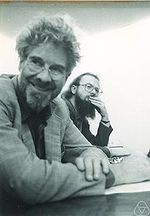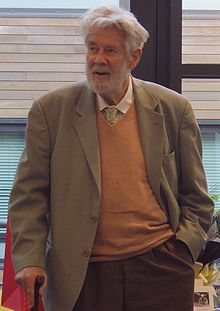- Christopher Zeeman
-
Professor Sir Erik Christopher Zeeman 
Erik Christopher Zeeman in 1980, courtesy MFOBorn 4 February 1925
JapanResidence United Kingdom Citizenship British Fields Mathematics Institutions University of Cambridge, England
University of Warwick, England
Oxford University, England
Gresham College, EnglandAlma mater University of Cambridge, England Doctoral advisor Shaun Wylie Doctoral students Tony Armstrong
Peter Buneman
David Epstein
John Hudson
Ray Lickorish
Anthony Manning
Tim Poston
Colin Rourke
Jaroslav Stark
David Trotman
Terry Wall
and 18 othersKnown for Catastrophe theory
Geometric topology
Singularity theoryNotable awards Senior Whitehead Prize (1982)
Faraday Medal (1988)
David Crighton Medal (2006)Notes
Fellow of the Royal SocietySir Erik Christopher Zeeman FRS (born 4 February 1925), is a Japanese-born British mathematician known for his work in geometric topology and singularity theory.
Zeeman's main contributions to mathematics were in topology, particularly in knot theory, the piecewise linear category, and dynamical systems.
His 1955 thesis at the University of Cambridge described a new theory termed "dihomology", an algebraic structure associated to a topological space, containing both homology and cohomology, introducing what is now known as the Zeeman spectral sequence. This was studied by Clint McCrory in his 1972 Brandeis thesis following a suggestion of Dennis Sullivan that one make "a general study of the Zeeman spectral sequence to see how singularities in a space perturb Poincaré duality". This in turn led to the discovery of intersection homology by Robert MacPherson and Mark Goresky at Brown University where McCrory was appointed in 1974.
Zeeman is known among the wider scientific public for his contribution to, and spreading awareness of catastrophe theory, which was due initially to another topologist, René Thom, and for his Christmas lectures about mathematics on television in 1978. He was especially active encouraging the application of mathematics, and catastrophe theory in particular, to biology and behavioural sciences.
Contents
Early life
Zeeman was born in Japan to a Danish father, Christian Zeeman, and a British mother. He and his parents moved to England one year after his birth. After being educated at Christ's Hospital in Horsham, West Sussex, he served as a Flying Officer with the Royal Air Force from 1943 to 1947. He studied mathematics at Christ's College, Cambridge, but had forgotten much of his school mathematics while serving for the air force. He received an MA and PhD (the latter under the supervision of Shaun Wylie) from the University of Cambridge, and became a Fellow of Gonville and Caius College where he tutored David Fowler and John Horton Conway.[1]
Academic career
Eric Christopher Zeeman is one of the founders of engulfing theory in piecewise-linear topology and is credited with working out the engulfing theorem (independently also worked out by John Stallings) which can be used to prove the piece-wise linear version of the Poincaré conjecture for all dimensions above four.[2][3] After working at Cambridge (during which he spent a year abroad at University of Chicago and Princeton as a Harkness Fellow) and the Institut des Hautes Études Scientifiques, he founded the Mathematics Department and Mathematics Research Centre at the new University of Warwick in 1964. In his own words
- I was 38 and had developed some fairly strong ideas on how to run a department and create a Mathematics Institute: I wanted to combine the flexibility of options that are common in most American universities, with the kind of tutorial care to be found in Oxford and Cambridge.[4]
Zeeman's style of leadership was informal, but inspirational, and he rapidly took Warwick to international recognition for the quality of its mathematical research. The first six appointments he made were all in topology, enabling the department to immediately become internationally competitive, followed by six in algebra, and finally six in analysis and six in applied mathematics. He was able to trade four academic appointments for funding that enabled PhD students to give undergraduate supervisions in groups of two for the first two years, in a manner similar to the tutorial system at Oxford and Cambridge. He remained at Warwick until 1988, but from 1966 to 1967 he was a visiting professor at the University of California at Berkeley, after which his research turned to dynamical systems, inspired by many of the world leaders in this field, including Stephen Smale and René Thom, who both spent time at Warwick, Zeeman subsequently spent a sabbatical with Thom at the Institut des Hautes Études Scientifiques in Paris, where he became interested in catastrophe theory. On his return to Warwick, he taught an undergraduate course in Catastrophe Theory which became immensely popular with students; his lectures generally were "standing room only". In 1973 he gave an M.Sc. course at Warwick giving a complete detailed proof of Thom's classification of elementary catastrophes, mainly following an unpublished manuscript, "Right-equivalence" written by John Mather at Warwick in 1969. David Trotman, then aged 21, attended this course, and wrote up his notes as his M.Sc. thesis. These were then distributed in thousands of copies throughout the world and published both in the proceedings of a 1975 Seattle conference on catastrophe theory and its applications,[5] and in a 1977 collection of papers on catastrophe theory by Zeeman.[6] In 1974 Zeeman gave an invited address at the International Congress of Mathematicians in Vancouver, about applications of catastrophe theory.
Zeeman was elected as a Fellow of the Royal Society in 1975, and was awarded the Society's Faraday Medal in 1988. He was the 63rd President of the London Mathematical Society in 1986–88 giving his Presidential Address on 18 November 1988 On the classification of dynamical systems. He was awarded the Senior Whitehead Prize of the Society in 1982. He was the Society's first Forder lecturer, involving a lecture tour in New Zealand, in 1987.
In 1978, Zeeman gave the televised series of Christmas Lectures at the Royal Institution. From these grew the 'Mathematics Master classes' for 13-year old children that now flourish in forty centres in the United Kingdom.[7]
In 1988, Zeeman became Principal of Hertford College, Oxford. The following year he was appointed an honorary fellow of Christ's College, Cambridge. He received a knighthood in 1991 for "mathematical excellence and service to British mathematics and mathematics education". On Friday 6 May 2005, the University of Warwick's new Mathematics and Statistics building was named the Zeeman building in his honour. In September 2006, it was announced that the London Mathematical Society and the Institute of Mathematics and its Applications will award him the David Crighton medal, in recognition of his long and distinguished service to mathematics and the mathematical community.[8] The medal is awarded triennially, and Zeeman will be the second ever recipient of the award.
The Christopher Zeeman Medal for Communication of Mathematics of the London Mathematical Society and the Institute of Mathematics and its Applications is named in Zeeman's honour.[9] The award aims 'to honour mathematicians who have excelled in promoting mathematics and engaging with the general public. They may be academic mathematicians based in universities, mathematics school teachers, industrial mathematicians, those working in the financial sector or indeed mathematicians from any number of other fields'.
Notes
- ^ The Guardian, Obituary: David Fowler, 3 May 2004
- ^ 'The generalised Poincaré conjecture', Bull. Amer. Math. Soc. 67:270 (1961)
- ^ 'The Poincaré conjecture for n greater than or equal to 5', Topology of 3-manifolds and related topics (Proc. The Univ. of Georgia Institute, 1961), 198–204, Prentice–Hall, 1962
- ^ E.C.Zeeman, Mathematical Association President's report, 2004, M-A.org.uk
- ^ D.J.A.Trotman and E.C.Zeeman, The classification of elementary catastrophes of codimension less than or equal to 5, in Structural stability, the theory of catastrophes, and applications in the sciences. Proceedings of the Conference held at Battelle Seattle Research Center, Seattle, Wash., April 21–25, 1975. Edited by P. Hilton. Lecture Notes in Mathematics, Vol. 525. Springer-Verlag, Berlin-New York, 1976
- ^ E. C. Zeeman, Catastrophe theory. Selected papers, 1972–1977. Addison–Wesley Publishing Co., Reading, Mass.–London–Amsterdam, 1977
- ^ "Events programme for maths, Secondary Mathematics Masterclasses". http://www.rigb.org/events/programmeformaths_second.jsp. Retrieved 2008-01-02.
- ^ London Mathematical Society. "Honours and Awards Newsletter". http://www.lms.ac.uk/newsletter/352/352_03.html. Retrieved 2007-07-08.
- ^ "The Christopher Zeeman Medal for Communication of Mathematics". http://www.ima.org.uk/news/christopher_zeeman_medal.htm. Retrieved 2008-01-02.[dead link]
See also
- Stallings–Zeeman theorem
External links
- O'Connor, John J.; Robertson, Edmund F., "Christopher Zeeman", MacTutor History of Mathematics archive, University of St Andrews, http://www-history.mcs.st-andrews.ac.uk/Biographies/Zeeman.html.
- Interview in CIM Bulletin 2001
- Three references for further reading
- Bibliography
- Zeeman's Catastrophe Machine
- "The Cusp of Catastrophe: René Thom, Christopher Zeeman and Denis Postle" in Maps of the Mind Charles Hampden-Turner. Collier Books, 1981. ISBN 978-0855332938
- Christopher Zeeman at the Mathematics Genealogy Project.
Categories:- 1925 births
- Living people
- Christ's Hospital Old Blues
- Fellows of the Royal Society
- British mathematicians
- 20th-century mathematicians
- Topologists
- Harkness Fellows
- David Crighton medalists
- Honorary Fellows of Christ's College, Cambridge
- Alumni of Christ's College, Cambridge
- Academics of the University of Warwick
- Presenters of the Royal Institution Christmas Lectures
- Professors of Gresham College
Wikimedia Foundation. 2010.

